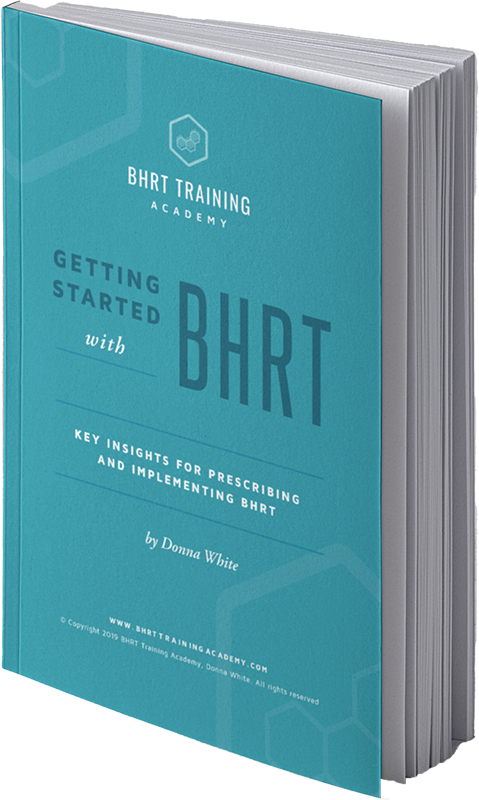How to Assess and Treat Hormonal Imbalance in Women

Hormonal imbalance in women is extremely common, especially around menopause. Symptoms like hot flashes, night sweats, foggy thinking, low sex drive, weight gain, fatigue, and mood problems can impair a person’s daily life and sometimes be debilitating.
Here we’ll review the common causes of hormone imbalance and then discuss the potential benefit of bioidentical hormones along with hormone balancing protocols for these patients.
You can help your patients reduce physical symptoms and mood swings brought on by hormonal imbalance with Bioidentical Hormone Replacement Therapy (BHRT)—this treatment is considered effective by many health practitioners.
Learning to prescribe hormone therapies like BHRT is considered a safe and effective way to offer patients many benefits.
Causes of Hormonal Imbalance in Women
The critical role of hormones in the body cannot be understated. They are chemical messengers vital to the body, and balancing them can be precarious. That’s why health treatments that take a holistic view can be more effective than treatments that are symptoms specific, e.g., hormone therapy alone.
Some causes of hormonal imbalance in women include:
- Age
- Menopause
- Perimenopause
- PMS
- Problems with the thyroid and/or adrenal glands
- Stress
- Birth control
- Reproductive health issues like PCOS
- Endocrine disruptors (Xenoestrogens)
- Weight gain
- Ovarian Dysfunction or failure to ovulate
- The use of (non-bioidentical) hormone therapies
- Genetic propensity
- Food allergies or intolerances
- Gut dysbiosis
- Mitochondrial dysfunction
- Inflammation
Plenty of other health problems can cause and result in hormonal imbalance, including eating disorders, Alzheimer’s disease, and serious illnesses such as cancer. Consistently imbalanced hormone levels can also trigger diseases like osteoporosis and heart disease, and the risk of this increases with age.
Practitioners should be willing to look outside the box and offer treatments that both they and their patients can feel good about.
About Hormonal Imbalance in Women
Hormones tend to fluctuate at different points in life, including during perimenopause and menopause.
Although other hormones such as thyroid and adrenal hormones may also have an effect, the main symptoms to be considered for women considering Bioidentical Hormone Replacement Therapy (BHRT) are:
- Irregular periods
- Low sex drive
- Vaginal dryness
- Insomnia
- Fatigue
- Hot flashes
- Depression
- Memory problems
- Brain fog
- Digestion problems
- Mood swings
- Weight gain
- Infertility
- Thinning hair
- Brittle nails
- Muscle loss
- Changes in skin and hair texture
Treatments such as BHRT offer comprehensive, individualized treatment, give women more opportunities to ask questions, discover key causes, and feel more empowered about managing symptoms.
Menopause and Hormone Therapy
Bioidentical Hormone Replacement Therapy can help women effectively manage symptoms from menopause and is growing in popularity for this use. The fluctuating hormones during this time require regular testing and a comprehensive treatment plan. Practitioners should consider patent history, genetics, and lifestyle factors in long-term treatment.
Allergies and infections can also be addressed.
During menopause, estrogen is the primary hormone that declines. Those with low estrogen may want to consider hormone therapy treatments.
During perimenopause, the 5-15 years before actual menopause, estrogen levels can fluctuate, increase, and become unbalanced with progesterone. This is worsened by the fact that progesterone levels typically decline starting in the mid-thirties, leading to estrogen dominance.
Progesterone therapy can help offset estrogen dominance, especially if women are experiencing symptoms such as heavy flow and frequent periods of intense PMS. Progesterone deficiency is common during perimenopause and menopause when ovulation ceases or sputters. It can also result from oophorectomy, birth control pills, stress, thyroid problems, or nutrient deficiencies.
Hormonal Imbalance in Women: Treatment
Often, more than one contributing factor can cause or exacerbate symptoms of hormonal imbalance. Therapies like BHRT can offer effective treatment plans which may allow practitioners to avoid medications that can just mask the symptoms (such as antidepressants) without getting to the sources of the problem. If conventional prescriptions are required, they can be considered in tandem with a whole health plan.
The first step typically involves assessing symptoms, health history, exam, and hormone testing. A comprehensive wellness plan involving complementary treatments can be developed for each patient’s unique set of needs. Treatment plans typically consist of bioidentical hormones and/or hormone-balancing supplements, along with dietary and lifestyle protocols.
As a BHRT provider or a provider that is interested in learning more about correcting hormone imbalance, there are numerous tools and protocols at your disposal to treat hormonal imbalance in women.
Start Offering Bioidentical Hormone Replacement Therapy
Maintaining balanced hormones is required for optimal health and disease prevention. If these symptoms persist, there can be more serious ramifications such as hormone-related cancers, bone loss, heart disease, or cognitive decline.
Health practitioners looking for alternative solutions for patients struggling with menopause and other health issues related to hormonal imbalance can use BHRT to help patients improve their quality of life.
Schedule a free strategy call to learn more about how you can start offering BHRT to your patients.
Enjoyed this article? Here are three more to help you:

Get the quick read ebook,
Getting Started with BHRT -
Key Insights to Prescribing and Implementing BHRT.
CME's - Earn while you learn.
